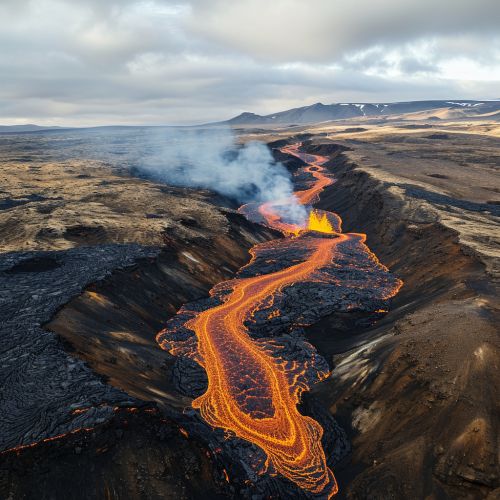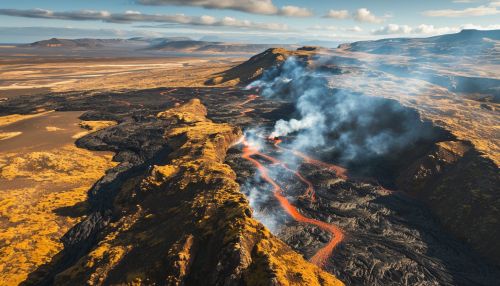Iceland hotspot
Introduction
The Iceland hotspot is a volcanic hotspot located near Iceland, an island country in the North Atlantic Ocean. This hotspot is a significant geological feature, responsible for the formation of Iceland itself and the ongoing volcanic activity in the region. It is a part of the larger Mid-Atlantic Ridge, where the North American and Eurasian tectonic plates are diverging.


Geology
The Iceland hotspot is believed to be the surface expression of a deep mantle plume, a column of hot rock rising from near the Earth's core-mantle boundary. This plume is thought to be responsible for the high volcanic activity in Iceland, which is much greater than would be expected from plate tectonics alone. The hotspot's location on the Mid-Atlantic Ridge, a divergent tectonic boundary, allows magma from the mantle plume to reach the surface and create new crust.
Mantle Plume
The mantle plume theory, first proposed in the 1970s, suggests that hotspots like the Iceland hotspot are fed by narrow streams of hot mantle material rising from deep within the Earth. These plumes are thought to be relatively stationary, with the tectonic plates moving over them. The Iceland hotspot's location on the Mid-Atlantic Ridge and its high level of volcanic activity provide strong evidence for the existence of a mantle plume beneath Iceland.
Volcanic Activity
The Iceland hotspot is one of the most volcanically active regions in the world. The island of Iceland has over 130 volcanoes, many of which are still active. This high level of volcanic activity is due to the combination of the mantle plume and the divergent tectonic boundary at the Mid-Atlantic Ridge. The hotspot is responsible for the formation of many of Iceland's most notable geological features, including its many volcanoes, geysers, and hot springs.
Impact on Iceland
The Iceland hotspot has had a profound impact on the geography, ecology, and human history of Iceland. The island's unique landscape, rich in volcanoes, geysers, and hot springs, is a direct result of the hotspot's activity. The hotspot also influences Iceland's climate and ecology, contributing to the island's unique biodiversity.
Geography
The Iceland hotspot has shaped the island's geography in many ways. The ongoing volcanic activity has created a diverse landscape, with features ranging from lava fields and volcanic craters to geysers and hot springs. The hotspot is also responsible for the formation of Iceland's highlands, which are among the largest uninhabited and unspoiled areas in Europe.
Ecology
The Iceland hotspot also plays a role in the island's ecology. The volcanic soil, rich in minerals, supports a unique array of plant life. The geothermal activity associated with the hotspot also creates unique habitats for a variety of species. For example, the hot springs and geysers provide warm environments that are home to thermophilic organisms, organisms that thrive in high-temperature environments.
Human History
The Iceland hotspot has also influenced human history on the island. The abundant geothermal energy provided by the hotspot has been harnessed for power generation, making Iceland one of the world leaders in renewable energy. The unique landscape created by the hotspot has also shaped Icelandic culture, influencing everything from mythology to modern tourism.
See Also
References
1. Morgan, W. J. (1971). "Convection plumes in the lower mantle". Nature. 230 (5288): 42–43. 2. Schilling, J.-G. (1973). "Iceland mantle plume: Geochemical study of Reykjanes Ridge". Nature. 242 (5392): 565–571. 3. Thordarson, T.; Larsen, G. (2007). "Volcanism in Iceland in historical time: Volcano types, eruption styles and eruptive history". Journal of Geodynamics. 43 (1): 118–152.
